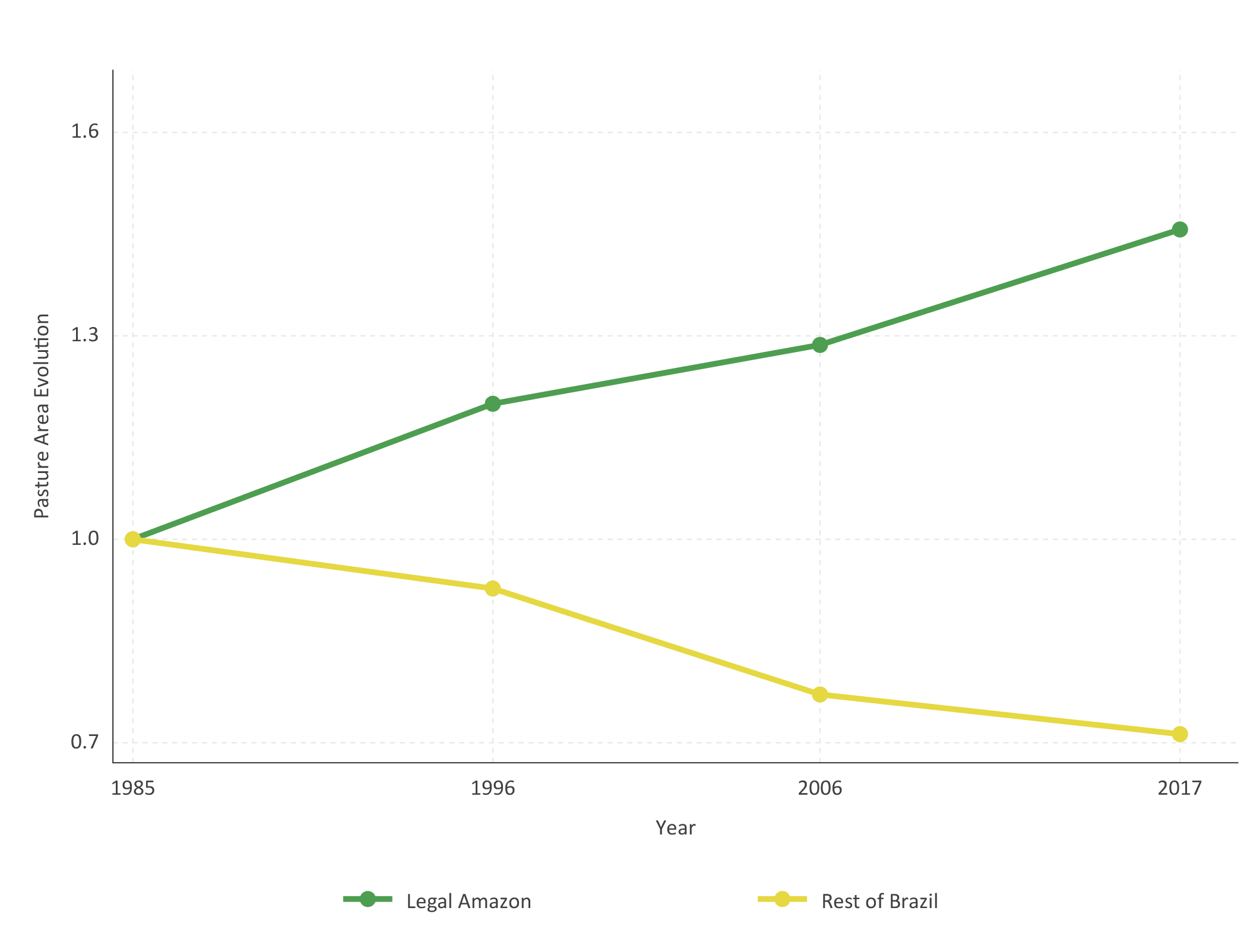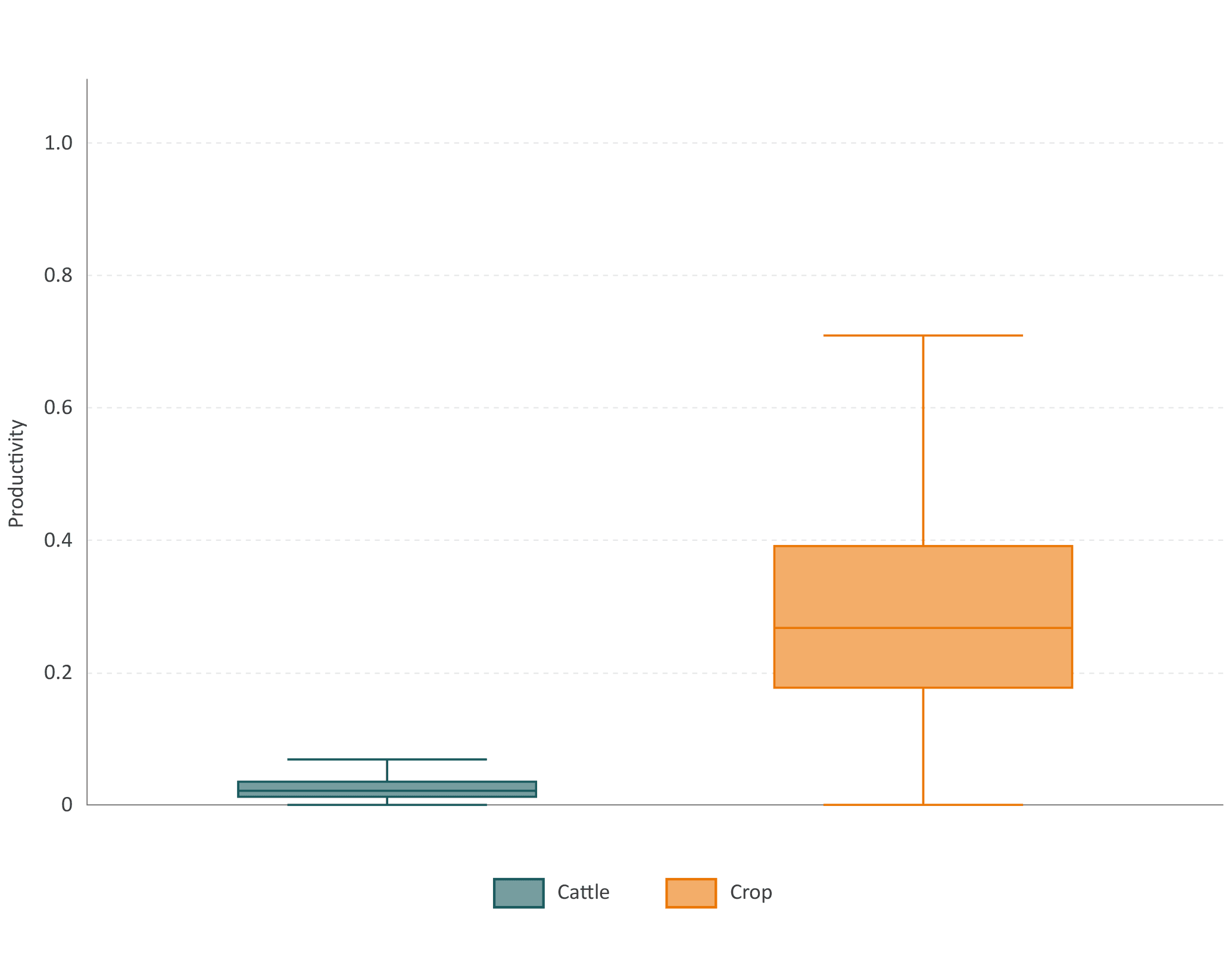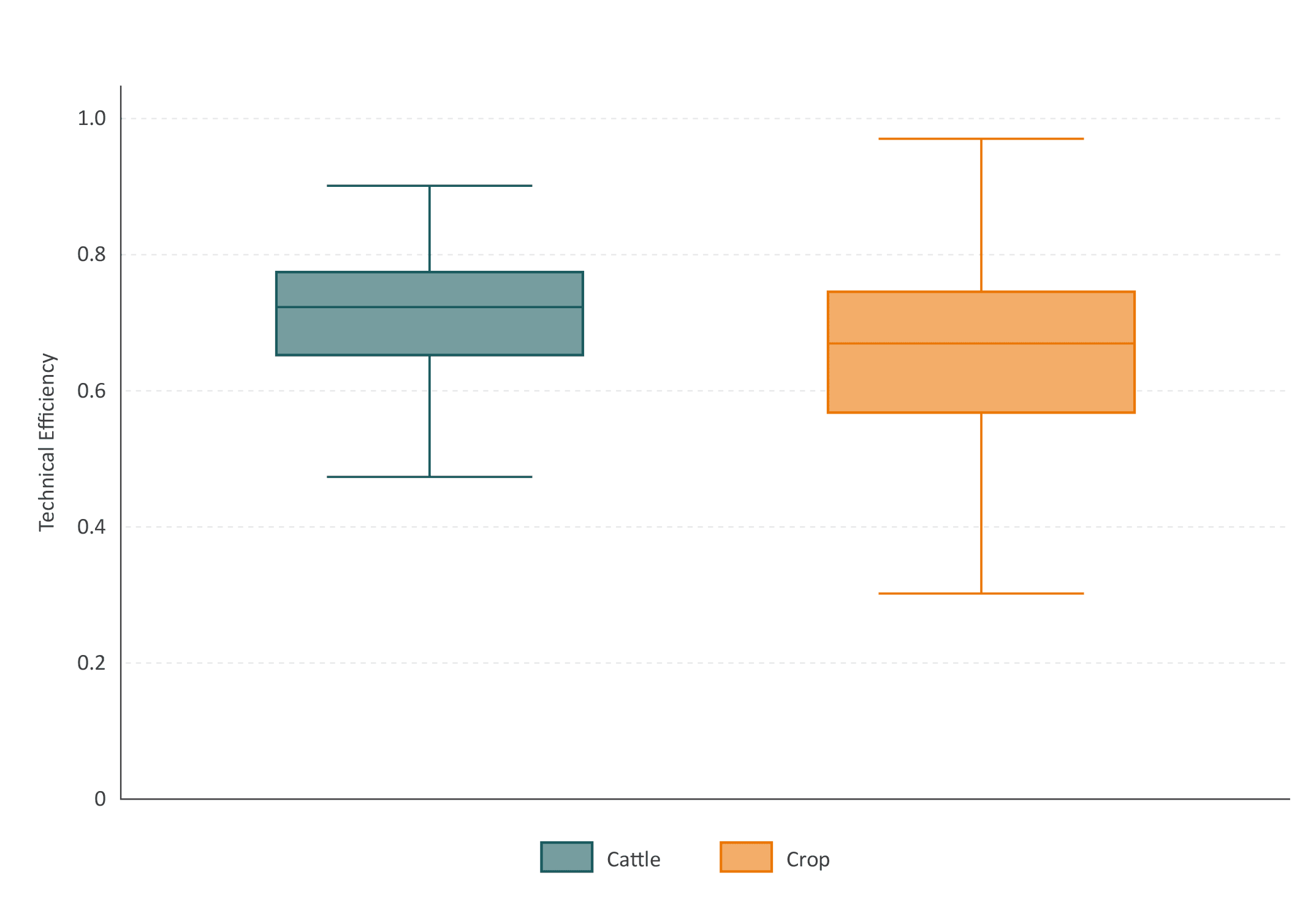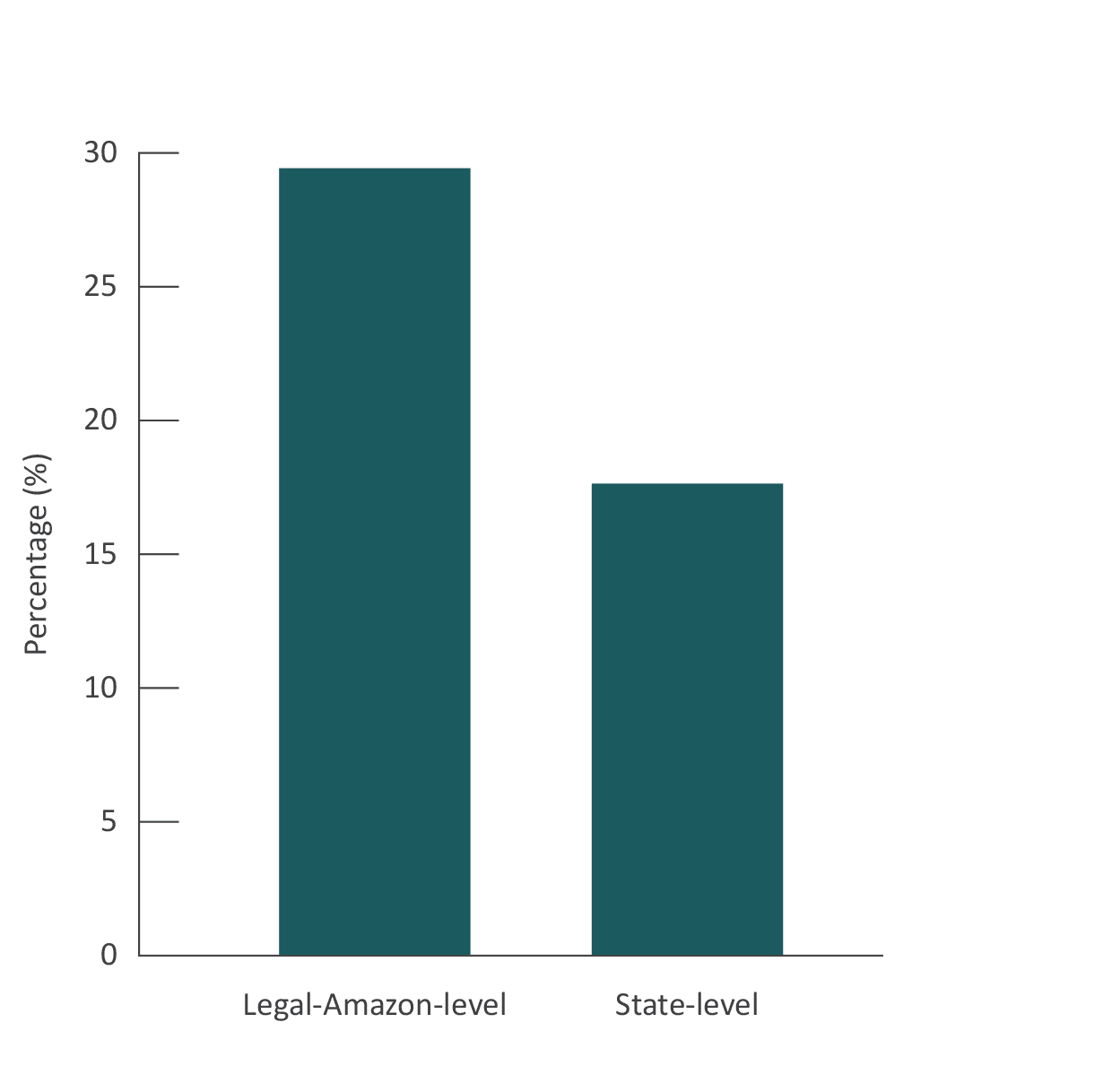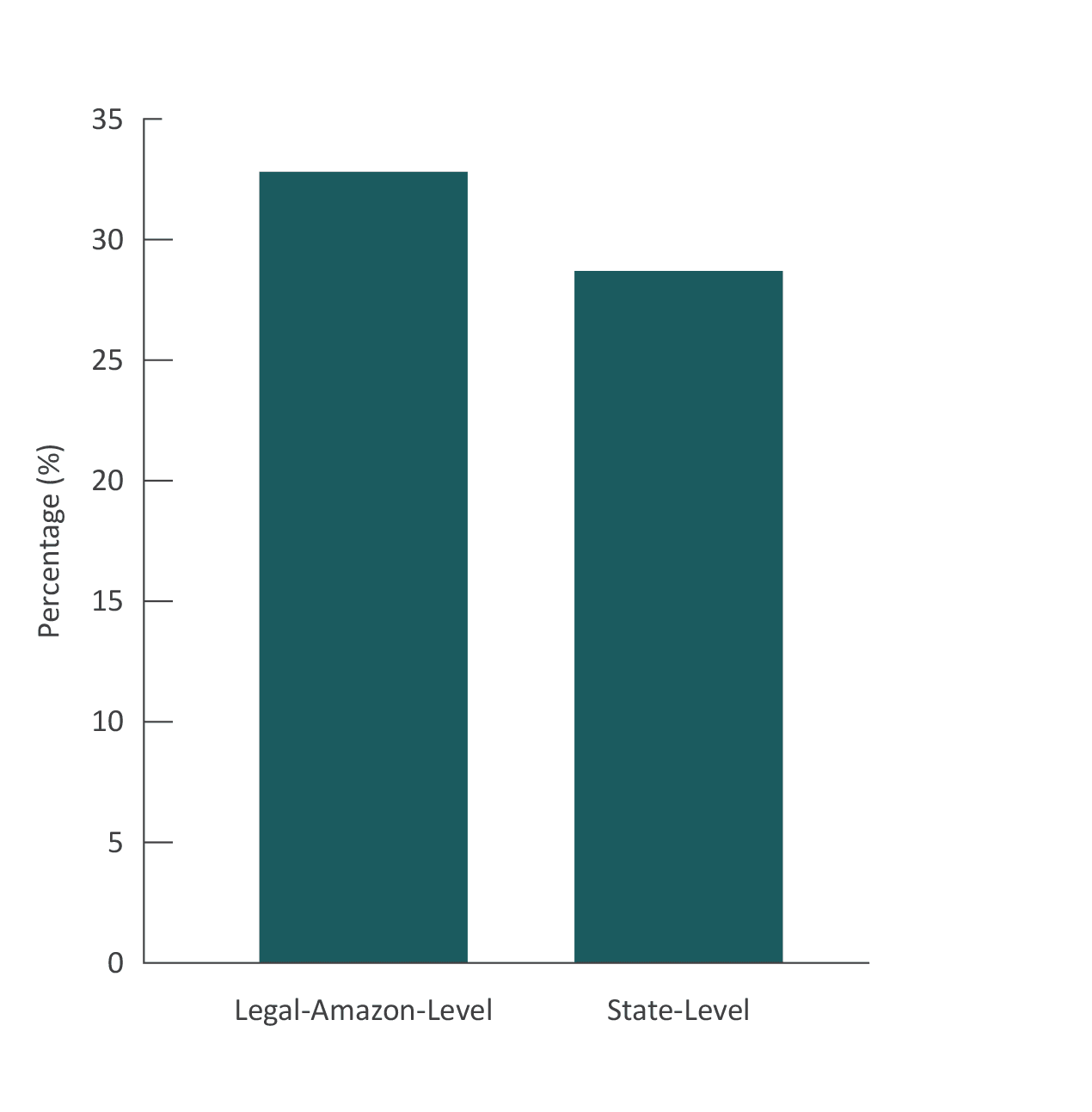Cattle ranching is associated with deforestation in the Amazon region – a large part of the deforested areas have been converted to pasture. This pattern of extensive cattle ranching in the Amazon region is distinguished from the rest of Brazil. While the rest of Brazil uses less pasture over time for livestock production, the opposite is happening in the Amazon region, with an expansion of the pasture area (Figure 1). However, the role of livestock as a cause of deforestation is less evident. On the one hand, the expansion of the activity in the region can lead to deforestation. On the other hand, land grabbing has used livestock as part of the process of occupation of the territory.[1],[2] In this case, livestock would be more a consequence of land grabbing and deforestation than a cause.
In this context, reducing the conversion of forests into pastureland while protecting or increasing rancher’s livelihoods is one of the main challenges for promoting sustainable development in the Legal Amazon.[3] A key component to achieving this goal is increasing pasture productivity.
This brief summarizes the findings from Climate Policy Initiative/Pontifical Catholic University of Rio de Janeiro (CPI/PUC-Rio) that calculates the potential for increasing pasture productivity in the Legal Amazon by disseminating technologies that are widely used in just some parts of the region to all parts of the region.
Figure 1. Evolution of Pasture Area, 1985-2017
Source: CPI/PUC-Rio with data from the 1985, 1996, 2006, and 2017 Agricultural Census, 2021
Agronomic models estimate that it is possible to nearly triple Brazil’s pasture productivity through a combination of better management and ranching intensification.[4],[5] From the point of view of public policies, it is important to understand the origin of the productivity gains identified in the agronomic models. Are these gains mainly found in the dissemination of practices already widely used in some high-productivity municipalities? Or do they require the introduction of production models that use practices not widely used in the Legal Amazon? This distinction has important implications for both the design of agricultural policies and, for example, for training policies and the dissemination of new technologies.
CPI/PUC-Rio researchers show that livestock productivity is quite homogeneous in the region, with a predominance of land extensive production, little use of inputs (based on data from the 2017 Agricultural Census, just 12% of the properties used machines and only 3% used liming to correct the soil for pasture), and overall low levels of productivity. This uniformity translates into small benefits from disseminating the practices already used in the most productive municipalities in the Legal Amazon to the other municipalities in the region. Researchers calculate that this kind of dissemination could increase the value of its livestock production without increasing deforestation in the Legal Amazon by 17.6-29.4%.
Although the estimated productivity gain is relevant, it is substantially less than the potential identified in the agronomic literature. It is also considerably less than the potential for productivity gains in Brazilian agriculture, as calculated in previous work by CPI/PUC-Rio.[6] This indicates that the achievement of major productivity gains for cattle ranching in the Legal Amazon will require the introduction of a new business model with the dissemination of techniques and technologies not yet used in scale in the region and also the fight against activities such as land grabbing that has used extensive and not very productive livestock farming as part of its processes.
Estimating Productivity Gains
Data from the 2017 Agricultural Census indicate that livestock productivity is much more similar between municipalities than grain productivity as a whole (Figure 2). One possible explanation for this result is that the predominant model of livestock production is more homogeneous in the region than the predominant model of grain production is more homogeneous in the region than the predominant model of grain production. However, another possible explanation for this result is that differences in conditions of climate, soil, and transport costs are more important for the production of grains than for the production of meat and milk.
Figure 2. Productivity of Cattle and Crop Production
Note: Productivity measured as production value per hectare and normalized between 0 and 1.
Source: CPI/PUC-Rio with data from the 2017 Agricultural Census, 2021
To differentiate between these explanations, CPI/PUC-Rio researchers decomposed the productivity of municipalities in livestock and crops between geographic factors and efficiency.[7] The analysis of the efficiency term confirms the conjecture that productivity in livestock is much more homogeneous in the region than productivity in farming (Figure 3). This suggests that there is a predominance of a land extensive livestock model, with low use of inputs and very low productivity in nearly the entire Amazon region. This contrasts with what happens in grain production, where there are greater differences in terms of technologies, inputs and productivity.
Figure 3. Technical Efficiency of Cattle and Crop Production
Note: Technical efficiency term is the result of the SFA and was normalized between 0 and 1.
Source: CPI/PUC-Rio with data from the 2017 Agricultural Census, 2021
A direct consequence of the relatively similar productivity in cattle production across the Legal Amazon is that the potential to increase production in the region by disseminating the techniques and technologies already used in the most productive municipalities will be small. The results indicate that making all municipalities as productive as the best municipalities in the region would increase the value of cattle production in municipalities in the Legal Amazon by about 29% without deforestation (Figure 4). Making all municipalities as productive as the best municipalities in each state would increase production by 17% (Figure 4).
Figure 4. Potential to Increase Cattle Production
Note: Secondary sources include the FAO, MapBiomas, Matsuura and Wilmott databases.
Source: CPI/PUC-Rio with data from the 2017 Agricultural Census, 2021
The state of Pará has the greatest potential to make all its municipalities as productive as the most productive municipality, 27% (Table 1). These gains fall to about 17% in the states of Mato Grosso and Maranhão and to less than 10% in states like Rondônia and Acre.
Table 1. Potential to Increase Cattle Production by State
| VALUE OF CATTLE | |
| Legal-Amazon-Level | 29.43% |
| Pará | 27.32% |
| Tocantins | 18.62% |
| Mato Grosso | 17.79% |
| Roraima | 17.67% |
| State-Level | 17.64% |
| Maranhão | 17.35% |
| Amapá | 15.44% |
| Amazonas | 11.91% |
| Rondônia | 8.40% |
| Acre | 7.08% |
Source: CPI/PUC-Rio with data from the 2017 Agricultural Census, 2021
Interestingly, allowing deforestation to occur in these estimates does not significantly influence the results (Figure 5 shows only minor improvements compared to Figure 4). This highlights the limited potential to increase production through the dissemination of current technologies and practices, even when forest clearing is possible.
Figure 5. Potential to Increase Cattle Production – Allowing Deforestation
Note: Secondary sources include the FAO, MapBiomas, Matsuura and Wilmott databases.
Source: CPI/PUC-Rio with data from the 2017 Agricultural Census, 2021
Potential Approaches to Increase Cattle Productivity
Previous studies by CPI/PUC-Rio estimate a large potential to increase grain production in Brazil without causing deforestation.[8] The researchers found that Brazil could increase crop output by 79.0-104.5% without increasing deforestation in 2006. Replicating those numbers to the Legal Amazon in 2017 generates potential gains of 49.6%. Compared to the estimates presented in this study, the potential to increase cattle production in the Legal Amazon region varied between 17.6-29.4% without increasing deforestation.
The stark difference between the potential to increase crop production compared to cattle production reflects the prevalence of a land extensive livestock business model with low input intensity and productivity throughout the Legal Amazon region. This business model contrasts with what occurs in the production of grains, where in some regions, highly specialized commercial producers using modern inputs intensively predominate, whereas in other regions, family farmers operating with traditional technologies predominate. This implies that, while in grain production there is ample room for productivity gains through the dissemination of technologies used in the most productive regions, these kinds of gains are more limited for cattle.
It is important to note that these results do not mean that there are no ranchers using modern and extremely productive technological packages in the Legal Amazon, but that the predominant model in the region is characterized by little use of technology and low productivity. This indicates that the productivity growth for livestock in the Amazon region requires solutions that change the incentives to use technology to increase productivity in the region as a whole and not only to stimulate the expansion of the model already used in some more productive municipalities than others.
There are two promising paths for driving productivity gains. A first path is to scale up initiatives to disseminate new techniques that are underused in the region. An example to be followed is the Pecuária Verde project, developed in six farms in Paragominas (PA) in 2011.[9] This project included an initiative to help intensify livestock, which increases profit because it strongly reduces production costs per arroba produced with productivity gains. A second example is Sustainable Livestock in the Amazon (Pecuária Sustentável da Amazônia – PECSA), a company that invests to enhance the sustainability of farms in the region. This company leases farms with degraded pastures and invests in the reform of these pastures and in the implementation of a sustainable production model. A third example is the crop-livestock integration system on a single farm (ICLS).[10] Studies show that ICLS has an economic and environmental advantage compared to existing land extensive livestock management practices and other alternatives for intensifying pasture. Public policies and partnerships with slaughterhouses to improve the provision of information on modern ranching practices that respect the environment can be fundamental to allowing these initiatives to gain scale and effectively change the reality of livestock activity in the Legal Amazon.
A second way to drive productivity gains is to combat illegal occupation and illegal deforestation. Incentives for the use of good technologies are unlikely to succeed in changing the reality of cattle ranching in the Legal Amazon while the level of legal insecurity that characterizes agricultural activity in the region persists. In fact, the insecurity of property rights creates a context that encourages the practice of extensive cattle raising with very low productivity in recently converted forests whose return is not linked to the productive activity itself, but to land speculation. In this sense, the implementation of a robust set of policies aimed at controlling deforestation, the allocation of existing public lands, and the implementation of the Forest Code must, by reducing incentives for illegal occupation and illegal deforestation and bringing legal security to producers, encourage the intensification of cattle ranching and promote productivity gains.
[1] Stabile, M. C. et al. “Solving Brazil’s land use puzzle: Increasing production and slowing Amazon deforestation”. Land Use Policy 91 (2020). bit.ly/2PWVTsE.
[2] Azevedo-Ramos, C. et al. “Lawless land in no man’s land: The undesignated public forests in the Brazilian Amazon”. Land Use Policy 99 (2020). bit.ly/3b6kMto.
[3] Bragança, Arthur and Juliano Assunção. Assessing the Capital Costs of Maximizing Sustainable Agricultural Production in Brazil. Rio de Janeiro: Climate Policy Initiative, 2018. bit.ly/3eAm1D9; Assunção, Juliano and Arthur Bragança. Productivity for Cattle Ranching in Brazil: Pastureland Declines Might Show a New Pathway. Rio de Janeiro: Climate Policy Initiative, 2019. bit.ly/3vVg4qc.
[4] Agronomic models refer to models which simulate the production potential using detailed data on agro-climatic conditions and a given set of assumptions on practices, inputs, seeds etc.
[5] Strassburg, Bernardo B. N. et al. “When enough should be enough: Improving the use of current agricultural lands could meet production demands and spare natural habitats in Brazil”. Global Environmental Change 28 (2014): 84-97. bit.ly/3cYacpG.
[6] Bragança, Arthur and Juliano Assunção. Assessing the Capital Costs of Maximizing Sustainable Agricultural Production in Brazil. Rio de Janeiro: Climate Policy Initiative, 2018. bit.ly/3eAm1D9.
[7] The researchers used the Stochastic Frontier Analysis (SFA) method to perform this decomposition. All exercises assume that the existing area for the activity is fixed.
[8] Bragança, Arthur and Juliano Assunção. Assessing the Capital Costs of Maximizing Sustainable Agricultural Production in Brazil. Rio de Janeiro: Climate Policy Initiative, 2018. bit.ly/3eAm1D9.
[9] Silva, Daniel S. and Paulo Barreto. O aumento da produtividade e lucratividade da pecuária bovina na Amazônia: o caso do Projeto Pecuária Verde em Paragominas. Belém: Imazon, 2014. bit.ly/327vAm9.
[10] Garrett, R. et al. “Challenges and opportunities for the adoption of integrated farming systems: lessons from Brazil and beyond” In Embrapa Agrossilvipastoril-Artigo em anais de congresso (ALICE). International Symposium on Agricultural Technology Adoption 1, 2019, Campo Grande, MS. Studies, methods and experiences: abstracts. Campo Grande, MS: Embrapa Gado de Corte, 2020. bit.ly/3d0p5HX.

